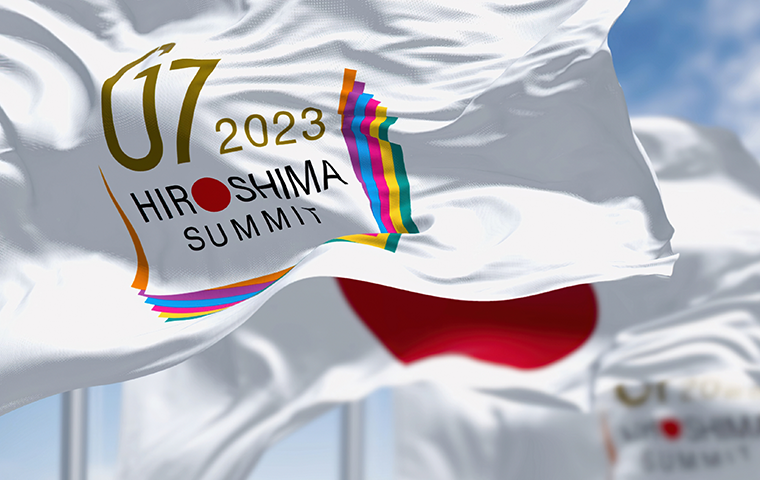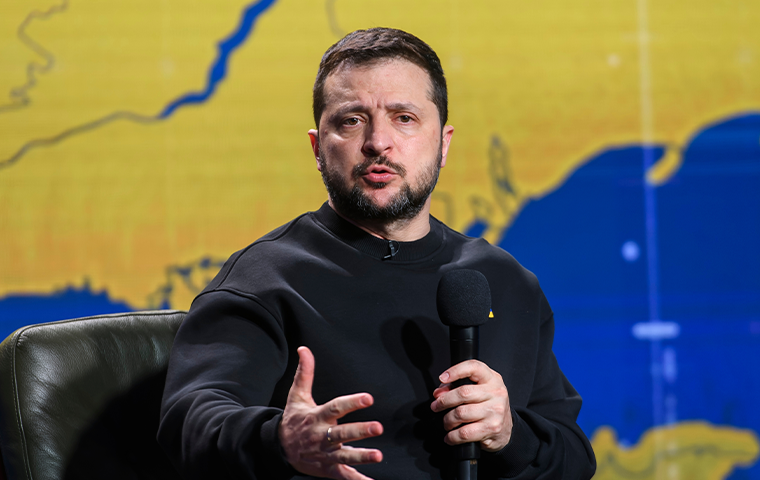Peace by Communicating the Realities of the Atomic Bombing: Interview with Hiroshima Mayor
Related Articles

At the G7 Summit in Hiroshima, the mayor of the atomic-bombed city, Kazumi Matsui, gave the world leaders a tour around Peace Memorial Park while advocating for the abolition of nuclear weapons. He talked to us about the significance of the event and the road toward peace.
(Interview by Gaiko Chief Editor)
– What are your thoughts on the significance and results of the G7 summit held in Hiroshima?
Matsui: At the summit, besides the G7 and the EU, leaders from eight invited countries, the heads of six international organizations, and Ukrainian President Volodymyr Zelensky came to Hiroshima. As the mayor of the host city, I believe the following two points were especially significant:
The first is that the leaders were able to come to the Peace Memorial Park, visit the Peace Memorial Museum, and listen to an atomic bomb survivor testimony. With our historic past, our emphasis is on communicating the realities of the atomic bombing. To promote our Peace Through Welcoming Visitors initiative, we have continued to submit requests to the Japanese government and embassies of various countries to have global leaders visit Hiroshima City. However, this is the first time that we were able to convey the realities of the atomic bombing at a gathering of heads of state, including nuclear powers. After their visit to the Peace Memorial Museum, the leaders wrote their messages in the Peace Memorial Museum guestbook, wishing for a peaceful world without nuclear weapons. Seeing this reminded me of the importance of having people learn about the tragic reality brought on by nuclear weapons.
The second was the announcement of the “G7 Leaders’ Hiroshima Vision on Nuclear Disarmament,” the first independent outcome document on nuclear disarmament issued at a G7 summit. In addition to the summit being held in the atomic-bombed city of Hiroshima, the current state of global affairs, which requires a serious discussion of nuclear disarmament, have contributed to forming the Hiroshima Vision. Although the G7 includes three of the nine nations that currently possess nuclear weapons (the U.S., the U.K., and France), I think it is important to note that the Vision clearly states the goal of realizing a world free from nuclear weapons, albeit under the condition of “undiminished security for all.” Of course, how this is put into practice is crucial, but I think it was good to reaffirm that the G7 and Hiroshima share a common end goal.
Sharing the Common Goal of Nuclear Abolition
– You personally showed the global leaders around Peace Memorial Park.
Matsui: A head of a municipal government rarely gets to speak face to face with the G7 leaders. I’m grateful for such an opportunity. In the Park where I showed them around, there is a cenotaph engraved with the words, “Let all the souls here rest in peace; for we shall not repeat the evil.” This is our answer to the appeal of the atomic bomb survivors that “no one else should suffer as we have.” It’s normal for people who experienced wars and conflicts to harbor feelings of hatred and revenge toward the opposite side. However, enduring the sorrows of the past, overcoming hatred, and praying for the coexistence and prosperity of all humankind, as well as the realization of true world peace is the Spirit of Hiroshima. I am confident that the leaders of the world took my message to heart.
– Some argue that the Hiroshima Vision doesn’t show a clear path to nuclear abolition.
Matsui: I am aware of such criticism. Yet, the current global situation regarding nuclear disarmament is quite serious. As you know, the nuclear disarmament and nonproliferation in the international community is based on the Treaty on the Non-Proliferation of Nuclear Weapons (NPT). The UN holds the NPT Review Conference every five years to examine the current situation and progress, as well as guarantee the treaty’s effectiveness. However, for the last two meetings, the conference has failed to adopt a final document. Efforts for disarmament have stalled in the international community.
Under such conditions, the G7, including the nuclear powers of the U.S., the U.K., and France, released a message to the world, stating we must not reverse the actions taken to reduce nuclear weapons, a world without nuclear weapons cannot be attained without nonproliferation, and people from around the world, including leaders, are encouraged to visit Hiroshima and Nagasaki for a deeper understanding on the realities of the bombings. This is a milestone when considering nuclear disarmament in the future. It’s not perfect, but let’s give credit where credit is due.
Beginning with the Realities of the Bombings

– There have been a diverse range of opinions expressed regarding nuclear weapons as the international tensions increase in countries near Japan.
Matsui: Amidst the increasingly challenging global situation, policymakers around the world are seriously considering how to maintain security for their countries. Diplomacy and security involve counterparties, and various political and administrative procedures are required, so policies cannot just be drawn on a blank slate. Looking at the current situation, nuclear disarmament has not progressed as envisioned in the NPT, and there are still ongoing discussions on nuclear deterrence. Some countries are also seeking to acquire nuclear weapons while pointing out the inequalities of the NPT. To achieve “peace,” some countries still choose nuclear weapons.
I’m in no position to judge whether the decisions made by each country are right or wrong. However, it’s the responsibility of politics to ensure civilians will not get involved in wars. The basis for this is imagining what befalls us when peace is broken. We are trying to tell the world about the realities of the atomic bombing because we want them to know what will happen once nuclear weapons are used. Without that awareness, real peace cannot be sustained. Obviously, nuclear weapons are not the means to that end.
– The atomic bomb survivors are getting older, with fewer opportunities to share their tragic experience. How can we pass on the issue of peace to the younger generation at home and abroad?
Matsui: In FY2012, we started a program for training legacy successors who can pass on the experiences of the atomic bombing in place of the aging survivors, to seamlessly convey to future generation their experiences of the atomic bombing and the wish for peace. Together with the atomic bomb survivors, these legacy successors are conveying the realities of the atomic bombing mostly to the younger generation, who visit Hiroshima on school trips and other occasions. Also, survivors and high schoolers in Hiroshima jointly create “Atomic bomb paintings” to convey the realities of the atomic bombing through the scenes that remain in the memories of the survivors of August 6, 1945.
Since 2020, 75 years after the atomic bombing, we have been holding Peace Education Webinars, where young people from Mayors for Peace member cities, both home and abroad, share information about their activities and exchange opinions online. We have also been holding Peace Night Hiroshima, in which young people take the initiative in planning and organizing an evening event at Peace Memorial Park to deliver a message of peace. Going forward, we hope to continue promoting such initiatives.
Civilian Reconciliation through Sister Park Agreement
– After the summit, a sister park agreement was signed between Hiroshima’s Peace Memorial Park and Hawaii’s Pearl Harbor National Memorial. Could you tell us how this came to be?
Matsui: In June 2012, one year after I became mayor, I visited the USS Arizona Memorial at the Pearl Harbor National Memorial. After offering flowers, I made a speech before the wall inscribed with the names of those who perished in the war. I stressed that now is the time for “peace through reconciliation” and called for its realization. I can still vividly recall the roaring applause of the audience.
Then, in 2017, Mr. Wayne Miyao, President of the Honolulu Hiroshima Kenjinkai, suggested a sister park agreement. At the time, however, we replied that it would take time to consider the matter. Five years later, Mr. Richard Mei, an embassy official at the U.S. Consulate, proposed using the Hiroshima G7 Summit as an opportunity to establish the sister park partnership. The importance placed on the “spirit of reconciliation,” coupled with the realization that the time had come to capitalize on President Miyano’s proposal, led to the signing of the agreement.
– While the partnership has attracted attention as a new approach to reconciliation, there were also mixed responses.
Matsui: I believe that while humans make the mistake of engaging in wars, we can always reconcile through reason and seek peace with a forward-thinking approach. I’m also aware that there are still ongoing debates on whether the atomic bombing was a necessary act by the U.S. to end the war and save lives, or if it was an unjust atrocity that requires apology and remorse. Some are critical of equating Pearl Harbor with Hiroshima. However, I believe the point many people in Hiroshima are stressing is that nuclear weapons must never be used again.
With that said,11 years after my visit to the USS Arizona Memorial, and 78 years after the end of World War II, the recent partnership will be a bridge of friendship for the people of Japan and the U.S., who were once foes. This also reciprocates the cumulative efforts of the predecessors of both countries who wished for peace. At the same time, I am convinced that this agreement will be an important step toward establishing a “culture of peace” in civil society, in which each citizen thinks and acts toward peace in their daily lives.
This is a translation of the Japanese article published in vol. 80 (Jul./Aug. 2023) of the Gaiko (Diplomacy) magazine.
Kazumi Matsui graduated from Kyoto University and joined the Ministry of Labour in 1976. After serving as the Assistant Minister of International Affairs at the Ministry of Health, Labour and Welfare, Japanese representative to the ILO Governing Body, and Director-General at the Secretariat of Central Labour Relations Commission, he became the Mayor of Hiroshima in 2011. He has been in office for four consecutive terms.




